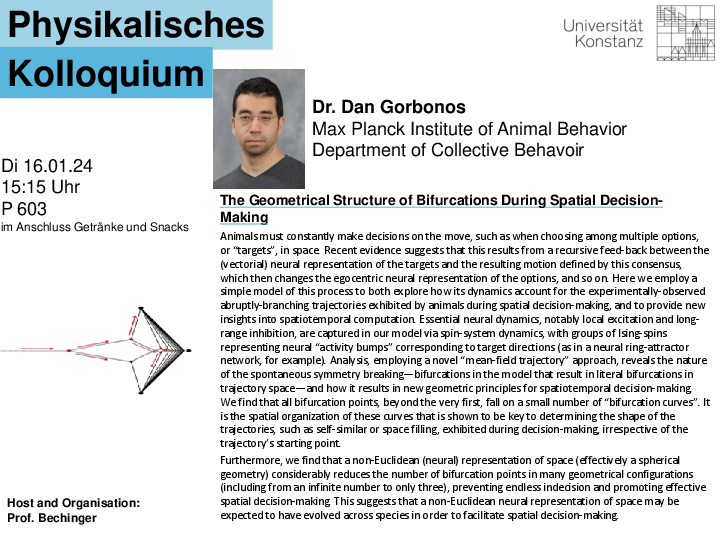Physikalisches Kolloquium: The Geometrical Structure of Bifurcations During Spatial Decision Making
Wann
Dienstag, 16. Januar 2024
15:15 bis 16:45 Uhr
Wo
P 603 im Anschluss Getränke und Snacks
Veranstaltet von
Host and Organisation: Prof. Bechinger
Vortragende Person/Vortragende Personen:
Dr. Dan Gorbonos Max Planck Institute of Animal Behavior Department of Collective Behavior
Animals must constantly make decisions on the move, such as when choosing among multiple options, or “targets”, in space. Recent evidence suggests that this results from a recursive feed back between the vectorial ) neural representation of the targets and the resulting motion defined by this consensus, which then changes the egocentric neural representation of the options, and so on. Here we employ a simple model of this process to both explore how its dynamics account for the experimentally observed abruptly branching trajectories exhibited by animals during spatial decision making, and to provide new insights into spatiotemporal computation. Essential neural dynamics, notably local excitation and long range inhibition, are captured in our model via spin system dynamics, with groups of Ising spins representing neural “activity bumps” corresponding to target directions (as in a neural ring attractor network, for example). Analysis, employing a novel “mean field trajectory” approach, reveals the nature of the spontaneous symmetry breaking bifurcations in the model that result in literal bifurcations in trajectory space and how it results in new geometric principles for spatiotemporal decision making.
We find that all bifurcation points, beyond the very first, fall on a small number of “bifurcation curves”. It is the spatial organization of these curves that is shown to be key to determining the shape of the trajectories, such as self similar or space filling, exhibited during decision making, irrespective of the trajectory’s starting point.
Furthermore, we find that a non Euclidean (neural) representation of space (effectively a spherical geometry) considerably reduces the number of bifurcation points in many geometrical configurations (including from an infinite number to only three), preventing endless indecision and promoting effective spatial decision making. This suggests that a non Euclidean neural representation of space may be expected to have evolved across species in order to facilitate spatial decision making.

